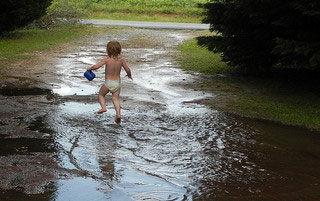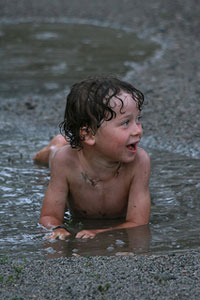Now that you have worked through the sections on allusion, metaphor, symbolism, and imagery, it’s time to identify these elements in one poem. The following poem was written by E.E. Cummings. He is known for his unique spacing, lack of capital letters, and vivid imagery.
 As you read the poem, highlight examples of imagery by clicking on words and phrases. Then, use your notes to answer the questions that follow. When you are finished with the questions, check your understanding to see some possible responses.
As you read the poem, highlight examples of imagery by clicking on words and phrases. Then, use your notes to answer the questions that follow. When you are finished with the questions, check your understanding to see some possible responses. 
Source: JOY 1 of 3, deb mae, Flickr
[in Just-]
in Just-
spring when the world is mud-
luscious the little
lame balloonman
whistles far and wee
and eddieandbill come
running from marbles and
piracies and it’s
spring
when the world is puddle-wonderful
the queer
old balloonman whistles
far and wee
and bettyandisbel come dancing
from hop-scotch and jump-rope and
it's
spring
and
the
goat-footed
balloonMan whistles
far
and
wee

Source: ez-mud-puddle, Jeremy OK, Flickr
- Cummings uses an allusion to the character Pan from Greek mythology. Look up who Pan is and what he is like. How is the balloon man like Pan?
- This poem is sometimes seen as a metaphor for children’s loss of innocence. Note the contrast between the children’s activities and the balloon man’s descriptions. What are the children doing when they hear the call of the balloon man? What phrases describe the balloon man? How does his image change as the poem progresses?
- Note that the author uses the word “spring” several times. Considering that the people who come running are young children, what might spring symbolize?
Sample Responses:
- Pan is a character who has cloven hooves and shaggy legs of a goat. He is known as a god of the woodlands and of merrymaking. He is often shown playing a flute and leading shepherds in a dance. The balloon man is like Pan because he lures the children away from their games.
- The children are playing games: marbles and piracies, hop-scotch, and jump-rope. The balloon man is described as “little lame,” “queer old,” and “goat-footed.” His image becomes more strange and threatening as the poem progresses.
- Spring is often thought of as a time when things begin to grow and mature. The balloon man leads the children away from childish games and draws them toward growing up.
Poetry may make you feel anxious sometimes because the meanings of poems are not always obvious. If you take your time and read poems carefully, however, you will get better at finding the techniques that poets use. This effort will increase your understanding of poetry and hopefully decrease your anxiety.